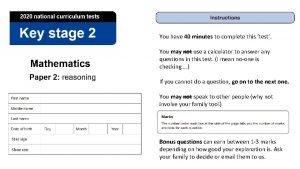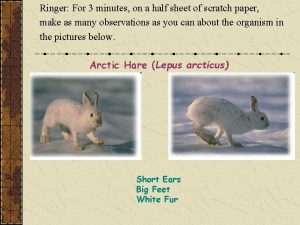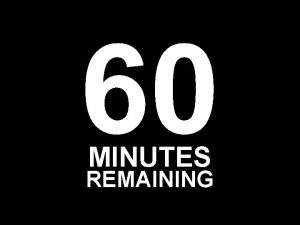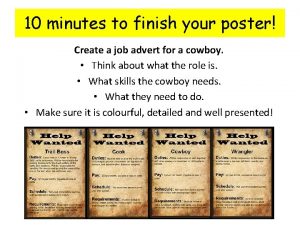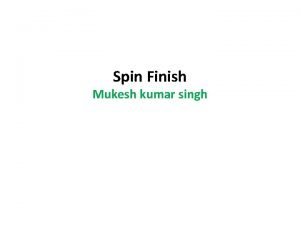45 minutes to finish your test and make




















- Slides: 20

45 minutes to finish your test and make corrections!

Unit 2 One-Variable Statistics

Two Main Uses of Statistics TO DESCRIBE (Data Analysis) TO PREDICT (Statistical Inference)

Definitions • Data: A collection of information in context. • Population: A set of individuals that we wish to describe and/or make predictions about. • Sample: A subset of the population that data is collected from. • Individual: Member of a population. • Variable: Characteristic recorded about each individual in a data set.

Types of Variables • Categorical Variable: A variable that records qualities or characteristics of an individual, such as gender or eye color. • Quantitative Variable: A variable that measures a characteristic of an individual, such as height, weight, or age. In this unit, we will focus on quantitative data.

What type is it? Categorical Quantitative

Categorical or Quantitative Data? • • Birth month Number of siblings Height in inches Average amount of time (in minutes) of your ride to school. Number of pets Year & model of the car you drive Age of your youngest parent Predicted letter grade of your first Math 1 test.

1. Brand of vehicle purchased by a customer 2. Price of a CD 3. Number of students in a class of 30 who prefer peanut M&Ms over plain M&Ms 4. Phone number of all the students enrolled in school. 5. The height of a 1 year old child. 6. Number of students in a class of 35 who turn in a term paper before the due date. 7. Gender of the next baby born at a particular hospital. 8. Amount of fluid (oz) dispensed by a machine used to fill bottles with soda. 9. Thickness of the gelatin coating of a Vitamin C capsule 10. Brand of computer purchased by a customer 11. State of birth for someone born in the United States. 12. Price of a textbook 13. The phone numbers of everyone in this class. 14. Actual weight of coffee in a one pound can. 15. The length of a rattlesnake.

Describing Data Two ways to describe data: • Graphically • Numerically

Describing Data Graphically • Dotplot • Histogram • Boxplot

Describing Data Numerically • Measures of Center – mean, median • Measures of Spread – range, interquartile range, standard deviation

Measures of Center What is the typical value?

Measures of Spread How much do values typically vary from the center? • Range • Interquartile Range (IQR) • Standard Deviation

Common Core Math I Unit 2 Days 17 and 18 Frequency Tables and Histograms

Link Up • Frequency Distribution Table • Histogram (by hand)

Describing Distributions • Shape • Center • Spread • Outliers

Shape • Mound shaped & symmetrical • Skewed left (extreme low values) • Skewed right (extreme high values) • Uniform

Center When describing a distribution at first, the center can be “eyeballed. ” Remember, you are trying to answer the question: “What is the most typical value? ”

Spread Range Remember, you are trying to answer the question: “How much do values typically vary from the center? ” BE SURE TO STATE EVERYTHING IN CONTEXT!!

NFL Rushing Statistics Group activity: • Make a frequency distribution table for your assigned column of data. • Draw the corresponding histogram on graph paper. • Write a paragraph about your data that addresses shape, center, spread, and outliers.
 1hr to sec
1hr to sec Confirm your email now and get 5 minutes as a gift!
Confirm your email now and get 5 minutes as a gift! I’m sorry that i didn’t finish my homework last night
I’m sorry that i didn’t finish my homework last night What did you do last friday
What did you do last friday You will have 40 minutes to complete the test.
You will have 40 minutes to complete the test. Reading test 35 minutes 40 questions
Reading test 35 minutes 40 questions Give us your hungry your tired your poor
Give us your hungry your tired your poor Make the lie big
Make the lie big Go make a difference
Go make a difference Make the lie big, make it simple
Make the lie big, make it simple Make your own folds and faults
Make your own folds and faults Sing and make music in your heart to the lord
Sing and make music in your heart to the lord Self ideal e self real
Self ideal e self real South tees mandatory training
South tees mandatory training Finishing line rpd
Finishing line rpd Precision attachment parts
Precision attachment parts What does romeo overhear juliet saying
What does romeo overhear juliet saying 6 minutes 40 seconds
6 minutes 40 seconds 3 minutes and a half
3 minutes and a half Compose your own parable
Compose your own parable How to make your school a better place
How to make your school a better place




